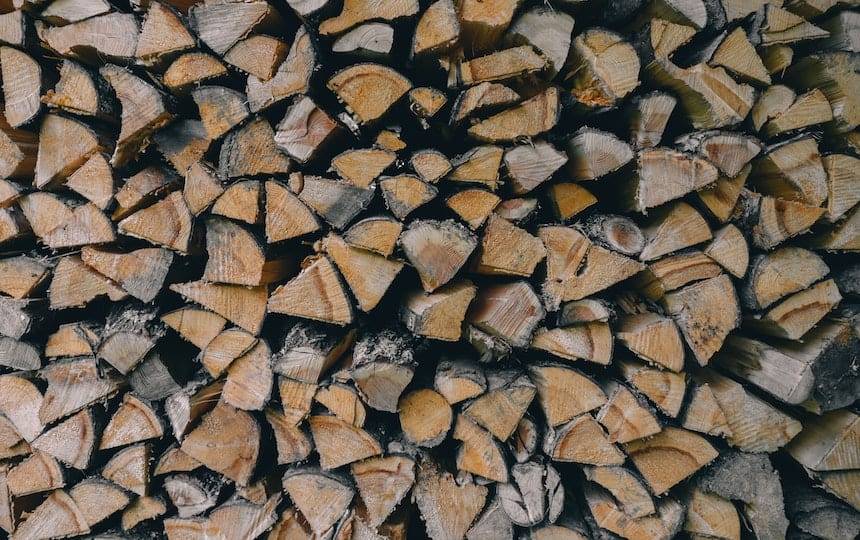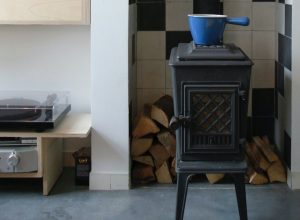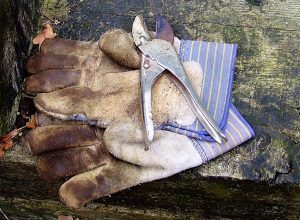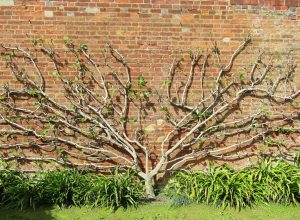Learn how to find your own firewood in the urban jungle. Our guide for urban foragers will help you ensure you burn wood safely and for free!
Is there anything more comforting than a crackling fire heating your home at this time of year? While they may be common for country homesteaders with private woodlots, urban permies need not miss out.
Commercial firewood is pretty pricey and you need to be careful where it is coming from. But there is a wealth of freely available wood in urban areas waiting to be harvested. Here’s how to heat your home for free (and provide cooking fuel and hot water to boot) in the ‘burbs.
The lowdown on wood stoves
Often frowned upon as carbon-spewing, there’s more to the story with modern wood stoves. Properly seasoned wood burnt in an efficient radiant heater is arguably more sustainable than using coal to power your split-system.
Wood is not a fossil-fuel – it is a renewable resource, and one you can even grow yourself. And in urban areas it is often a waste product that invariably finds its way into construction skips, hard rubbish piles or mulched into oblivion.
A note on stoves
Not all fires are equal. David Holmgren’s ‘Retrosuburbia’ has an excellent guide to the most efficient and sustainable types of wood-stoves.
To learn more about how to burn wood in the most sustainable way, check out Pip Issue 17 for our full fireplace guide or read this article for the basics on ensuring your wood heating is best practice.
So… here goes! Our urban firewood foragers guide to the universe!
Street tree pruning
Coppicing trees is the ultimate renewable wood supply. This is the practice of hard pruning trees regularly (rather than chopping the whole thing down) which stimulates the tree to regrow more wood, creating a carbon cycle. Councils provide their own useful coppicing firewood service in many urban areas when dealing with overhead wires.
Nominally they’re just doing their annual “prune” – but the astute urban forager knows better. Pruning around wires has got to be the one of the most abundant free sources of timber around.
We regularly pick up more than we can carry. And this includes sizeable branches cut down to a reasonable size. We’ve even staked out our favourite streets and have friends and relatives on notice to give us the alert when the arborists come for their annual visit.
Many street trees are some of the most prized hardwood varieties for fire places, including oaks, eucalypts, melaleucas and plane trees.
Grow your own
Okay, so you’re not going to be able to grow your annual timber supply on a quarter acre block, but you sure will be able to contribute to a woodstack. Fast growing pioneer species like wattle and tagasaste can grow to a harvestable size in just two seasons, and readily coppice too. And they’re a great way to add nitrogen to your soil in a permaculture system.
Long-term thinkers might also get inspired to re-forest urban wastelands, verges and nature strips, that may one day prove a useful resource for future generations. In our household we have roughly calculated how many trees we will need to plant annually to offset the wood burned over winter.
We did this by weighing the average amount of wood we use each night, and multiplied this by the number of nights we usually have a fire over the five months of the year we need to heat our home to get our annual weight.
Then we assumed that per tonne of firewood you use annually you need to plant 12.5 trees per year. Those numbers are based on the assumption that you will come back and coppice these trees in five year cycles so if you’re not planning on doing this then 12.5 trees per year per tonne is pretty conservative.
Growing your own productive trees can also be a good annual source of wood. Apple and pear wood are prized for fires. Prunings from other fruit trees make useful kindling, as do canes and vines that produce vigorous annual growth.
Green waste
There will always be trees coming down in the urban neighbourhood for a variety of reasons. Perhaps they’re overhanging a roof precariously, playing havoc with water pipes or simply look ugly.
If you let folks know you’re on the hunt for firewood you are bound to get alerts from savvy friends and neigbours when a tree is comi ng down close to your house. Keep a tarp in your boot, a pruning saw in your bike-basket and stay alert to the possibilty of dropping everything to get a load of logs.
Fence posts and construction waste
Technically you’re not supposed to burn construction timbers for fuel due to the risk of unknowingly burning treated wood, which is toxic to humans, animals and the environment.
That said, most hardwood used for indoor framing is not treated in Australia. While residential fence posts (the bits that go in the ground, not the palings) are often untreated too.
Fence posts are usually untreated hardwood (different species of gum or cyprus, depending on where you are in Australia). So if someone is pulling a fence down near you, have a chat to the fencers who will know the provinence of the timber they are working with. When a new fence is going up fencers must notch out posts to accommodate cross beams.
We have scored virgin red-gum “notchings” from fencers in our local area. Not only are these slow-burning, perfectly seasoned little nuggets pre-cut to size, they are diverting waste from construction skips into heating our home and cooking our food. And we can be sure that they are untreated and safe to burn.
Storm damage
When a storm hits your suburb, the aftermath can be a boon for the urban firewood forager. Our family love to go on walks around our neighbourhood with a little trolley and pruning saw to collect fallen limbs post-tempest.
Not only are we helping keep our town tidy, we’re working on our firewood stash for the next year, and having fun!
Pallets
Pallets are most commonly made of pine which is great for kindling or getting a fire going fast.
You should only ever use heat treated pallets marked with the “HT” symbol, as any others are likely to contain toxic chemicals such as methyl bromine.
In summary
- The moral of this story is that you should let your neighbourhood know you’re on the hunt for firewood. You will most certainly find you get more offers of wood than you can handle. Waste-wood is an urban issue. And processing and seasoning it into useful fuel can be a sensible way to heat your home.
- The secondary moral is this; be organised! Effectively processing and storing wood is a time intensive exercise, so the more efficiency you can have the better. Have places to accept, process and cure new wood set up before you start trying to stash timber.
And finally…
And most importantly, don’t burn bad wood! That is: green, unseasoned wood, wood that has been treated, painted or lacquered, or wood whose provinence you’re unsure of. Toxic smoke and belching chimneys give wood burners a bad name. Burn responsibly.
Like more articles like this one? Subscribe to Pip Magazine’s print or digital editions here.
And if you can’t get your hands on enough firewood for this season, we highly recommend getting Fair Wood to tide you over. Until the tree Gods bestoweth lumber upon you!









